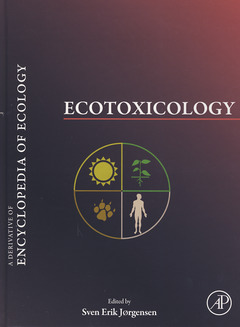Ecotoxicology
Langue : Anglais
Coordonnateur : Jorgensen Erik

Ecotoxicology offers an overview of current ecotoxicological problems. It includes basic ecotoxicological concepts, as well as information about chemicals and toxic substances that may cause harmful effects on the ecosystem and its living components. The book, with a total of 48 chapters, is divided into three parts. The first part includes the basic concepts of ecotoxicology, starting with an introductory chapter on ecotoxicology as a subdiscipline of ecology; assessment on ecotoxicological effects and risk; and properties and effects of toxic chemicals. These topics are further discussed throughout the book, along with nomenclature, focal topics, and the history of ecotoxicology. The two remaining parts tackle harmful properties and harmful chemicals. The second part also covers bioaccumulation, bioavailability, biodegradability, biodegradation, and biomagnification. It also provides models for ecotoxicological populations, ecosystems and landscapes, and on food-web bioaccumulation. Chemicals including benzene, copper, lead, nitrogen, phenols, pheromones, phthalates, plutonium, and uranium are covered in separate chapters in the final part. This book will be of great value to ecologists, ecotoxicologists, and environmental managers.
Chapter 1: Introduction (New)
Chapter 2: Ecotoxicology Nomenclature
Chapter 3: Ecotoxicology: the Focal Topics
Chapter 4: Ecotoxicology: The History and Present Directions
Chapter 5: Dose-Response
Chapter 6: Body Residues
Chapter 7: Assimilative Capacity
Chapter 8: Ecological Risk Assessment
Chapter 9: Biogeochemical Approaches to Environmental Risk Assessment
Chapter 10: Acute and Chronic Toxicity
Chapter 11: Bioaccumulation
Chapter 12: Biodegradability
Chapter 13: Biomagnification
Chapter 14: Ecological Catastrophe
Chapter 15: Ecotoxicological Models of Populations, Ecosystems and Landscapes
Chapter 16: Effects of Endocrine Disruptors in Wildlife and Laboratory Animals
Chapter 17: Epidemiological Studies of Reproductive Effects in Humans
Chapter 18: Exposure and Exposure Assessment
Chapter 19: Food-Web Bioaccumulation Models
Chapter 20: Mutagenesis
Chapter 21: Reproductive Toxicity
Chapter 22: Risk Management Safety Factors
Chapter 23: Hill’s Postulates
Chapter 24: Teratogenesis
Chapter 25: Antagonistic and Synergistic Effects Antifouling Chemicals in Mixture
Chapter 26: Antibiotics in Aquatic and Terrestrial Ecosystems
Chapter 27: Benzene
Chapter 28: Copper
Chapter 29: Crude Oil, Oil, Gasoline and Petrol
Chapter 30: Dioxin
Chapter 31: Endocrine Disruptors
Chapter 32: Endocrine Disruptor Chemicals: An Overview
Chapter 33: Halogenated Hydrocarbons
Chapter 34: Lead
Chapter 35: Nitrogen
Chapter 36: Persistent Organic Chemicals
Chapter 37: Phenols
Chapter 38: Pheromones
Chapter 39: Phthalates
Chapter 40: Plutonium
Chapter 41: Polychlorinated Biphenyls
Chapter 42: Polycyclic Aromatic Hydrocarbons
Chapter 43: Radioactivity
Chapter 44: Sediment Settings, Transport, Mineralization and Modeling
Chapter 45: Synthetic Polymers
Chapter 46: Uranium
Chapter 47: Veterinary Medicines
Chapter 2: Ecotoxicology Nomenclature
Chapter 3: Ecotoxicology: the Focal Topics
Chapter 4: Ecotoxicology: The History and Present Directions
Chapter 5: Dose-Response
Chapter 6: Body Residues
Chapter 7: Assimilative Capacity
Chapter 8: Ecological Risk Assessment
Chapter 9: Biogeochemical Approaches to Environmental Risk Assessment
Chapter 10: Acute and Chronic Toxicity
Chapter 11: Bioaccumulation
Chapter 12: Biodegradability
Chapter 13: Biomagnification
Chapter 14: Ecological Catastrophe
Chapter 15: Ecotoxicological Models of Populations, Ecosystems and Landscapes
Chapter 16: Effects of Endocrine Disruptors in Wildlife and Laboratory Animals
Chapter 17: Epidemiological Studies of Reproductive Effects in Humans
Chapter 18: Exposure and Exposure Assessment
Chapter 19: Food-Web Bioaccumulation Models
Chapter 20: Mutagenesis
Chapter 21: Reproductive Toxicity
Chapter 22: Risk Management Safety Factors
Chapter 23: Hill’s Postulates
Chapter 24: Teratogenesis
Chapter 25: Antagonistic and Synergistic Effects Antifouling Chemicals in Mixture
Chapter 26: Antibiotics in Aquatic and Terrestrial Ecosystems
Chapter 27: Benzene
Chapter 28: Copper
Chapter 29: Crude Oil, Oil, Gasoline and Petrol
Chapter 30: Dioxin
Chapter 31: Endocrine Disruptors
Chapter 32: Endocrine Disruptor Chemicals: An Overview
Chapter 33: Halogenated Hydrocarbons
Chapter 34: Lead
Chapter 35: Nitrogen
Chapter 36: Persistent Organic Chemicals
Chapter 37: Phenols
Chapter 38: Pheromones
Chapter 39: Phthalates
Chapter 40: Plutonium
Chapter 41: Polychlorinated Biphenyls
Chapter 42: Polycyclic Aromatic Hydrocarbons
Chapter 43: Radioactivity
Chapter 44: Sediment Settings, Transport, Mineralization and Modeling
Chapter 45: Synthetic Polymers
Chapter 46: Uranium
Chapter 47: Veterinary Medicines
Ecologists and Ecological Engineers
- Provides an overview of the theory and application of global ecology
- International focus and range of ecosystems makes Ecotoxicology an indispensable resource to scientists
- Based on the bestselling Encyclopedia of Ecology
- Full-color figures and tables support the text and aid in understanding
Date de parution : 04-2010
Ouvrage de 402 p.
20.9x27.7 cm
Mots-clés :
ecosystem; ecology; harmful chemicals; toxic substances; harmful effects; harmful properties
© 2024 LAVOISIER S.A.S.



